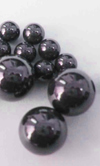That hollow feeling
 Following on from Anne Proffit's recent article on the application of hollow valves in drag-racing, we look at some of the more general benefits of hollow valves and their use in racing. These valves are used in all sorts of racing engines (and have also been used in production engines in the past). Particularly in Formula One they are used extensively.
Following on from Anne Proffit's recent article on the application of hollow valves in drag-racing, we look at some of the more general benefits of hollow valves and their use in racing. These valves are used in all sorts of racing engines (and have also been used in production engines in the past). Particularly in Formula One they are used extensively.
Whilst hollow valves would offer a weight saving over their solid equivalent (given the same stem diameter), they would be less stiff and so would almost certainly be a disadvantage in the case that the solid valve design which they replace was close to optimal. The decreased stiffness would mean less control over the valve head, with the attendant risk of it seating in an unsatisfactory manner, namely at the wrong time and with a higher than desired velocity.
The other option, if we aim to maintain axial stiffness, is to increase the outside diameter whilst maintaining cross-sectional area. Whilst this increases bending stiffness, which might be a worthwhile aim, the increased blockage offered to the flow of gas might be significant and require some alteration of the port profile in order to maintain the desired area schedule.
So, we might conclude, quite reasonably, that there is little real benefit in replacing a previously optimised solid valve with a hollow part of the same axial stiffness, unless there was a need to increase the bending stiffness of the valve. So, what is it about the hollow valve that makes it so valued by those seeking to optimise the performance of their engine? The answer can be given by a single word – cooling.
In general a hollow valve will not be strictly hollow, but will contain a coolant. The coolant is, certainly to the extent of my knowledge, always metallic. Low-melting point metals or alloys are used to remove heat from the valve head. A certain percentage of internal volume of the hollow valve is filled with the cooling material (I’m assured that this is not as easy as it sounds) and, as the liquid is splashed around, it removes heat from the valve head and conducts it more efficiently away from the area from which it is removed (generally through the valve guide).
‘Splashing around’ is not a good description, and we should be more specific - the cooling material, the most popular of which is sodium, oscillates along the stem owing to the acceleration of the valve, removing heat far more efficiently than the phenomenon of conduction. This is especially relevant if the valves are made of titanium, which has very low thermal conductivity. As we already know that titanium is a favoured valve material, we should not be surprised to learn that the use of sodium-cooled hollow valves is widespread, especially for exhaust valves. Sodium-filled inlet valves can be successful, although it is quite common for these simply to be hollow structures.
Later developments in hollow valve technology have concentrated on extracting extra mass by producing a hollow head – until fairly recently most racing valves relied on a simple drilled stem.
Written by Wayne Ward.